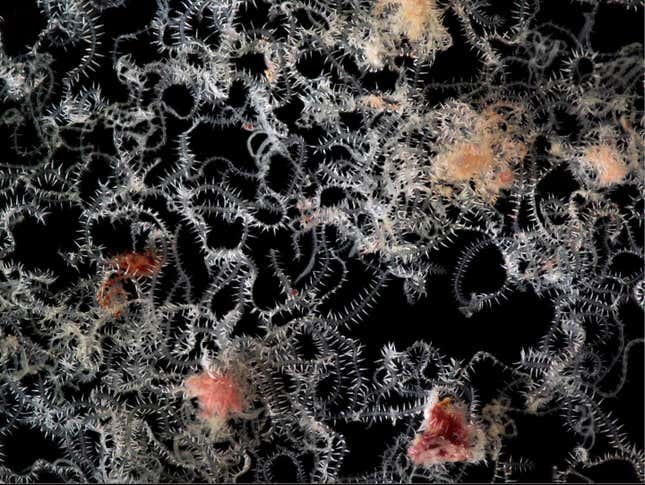
In Greek mythology, the hydra is a creature with many heads. In Norse mythology, Odin rides Sleipnir—a horse with many legs. And in the warm, coastal waters of Australia lives Ramisyllis multicaudata, the worm with many butts.
The creature is shaped somewhat like a tree, with a single head and a body that branches over and over again, each bifurcation gifted with its very own anus. Now, new research on the innards of this mysterious, multi-bottomed beast reveals that it’s even stranger on the inside.
Ramisyllis and one other related branching worm—Syllis—are found exclusively within the pores and canals inside marine sponges. They place their head somewhere near the sponge’s base and run their branched body through tunnels, extending to the outside of the sponge. M. Teresa Aguado, an evolutionary biologist at the University of Göttingen in Germany, and her colleagues think the worm’s forked figure is perfectly adapted for life in this Swiss cheese labyrinth. The branched body wouldn’t be suitable for swimming around in the outside ocean waters.
“However, living inside the sponge, the animal is protected, and explores the canals and easily moves inside,” said Aguado.
While scientists had gathered some understanding of Ramisyllis’ external anatomy since its discovery in 2006, little was known about how the worm’s insides were put together. So, Aguado and a team of researchers from Australia, Spain, and Germany found wild sponges containing the one-worm tangles and brought them into the lab.
There, the researchers used a combination of different imaging strategies to examine the worms and their porous abodes. They used a 3D X-ray method to see how Ramisyllis is arranged within its sponge host. The team also dissected the worms out of the sponges and used different types of microscopes to peer into Ramisyllis’ insides.
Their results—published recently in the Journal of Morphology—revealed that the worms’ rear ends are legion.

“We were able to count more than 500 [branches] in one specimen, but we think that they can easily reach 1,000,” said Aguado.
The team also found that the worms’ branching is well beyond skin deep. Incredibly, every time Ramisyllis forks itself, all the internal organs divide, too: The gut, the nerves, everything splits and runs the length of the branch. This also creates a unique, muscular band or “bridge” that threads between the organs every time the critter splits. These bridges can visually demarcate Ramisyllis’ main trunk, which is pretty useful when you’re observing an animal shaped like a tumbleweed.
The farther you get away from the head, the weirder the worm gets. Aguado and her colleagues were able to closely examine the tips of the branches, which are crucial for the species’ reproduction.
When Ramisyllis decides it’s time to procreate, its abundance of wandering derrières go through a transformation. The branch ends basically convert into genitals, filling with eggs or sperm. These reproductive units (or “stolons”) grow eyes and their own brains. When mature, the stolons detach and swim away, their freshly acquired “head” and eyes steering them to mate with stolons of the opposite sex. What started as a wriggling snarl of buttholes becomes a swarm of autonomous, sex-seeking torpedoes.

Non-branching worms in same family as Ramisyllis also use stolons in a similar manner, Aguado points out. But Ramisyllis is unique in the sheer volume of its carnal armada, thanks to its many hundreds of body branches.
Alexander Tzetlin, an invertebrate zoologist at Moscow State University in Russia who was not involved with this study, lauds the research, noting the obstacles in studying animals like Ramisyllis.
“In many cases, marine annelid [worms] are a very difficult object for research and observation, because they lead a secretive lifestyle,” said Tzetlin. “They live in shelters in pipes, burrows, or they simply dig in the thickness of the sediment, almost never appearing on the surface.”
Tzetlin also points out one big remaining mystery with Ramisyllis: its diet. No food has ever been found inside the worms’ intestines, just empty visceral real estate. It’s particularly baffling in an animal so ludicrously rich in anuses. There’s an awful lot of digestive infrastructure here to be building intestines to nowhere.
“We don’t know how this animal keeps its huge body having only one minute mouth,” says Aguado. “It may use the organic material in water that goes inside the [sponge] canals due to the currents generated by the sponge.”
Previous research showed that Ramisyllis has lots of long, microscopic extensions from its outer covering. These may absorb nutrients straight from the water.
Aguado says she and her colleagues are designing experiments to address this feeding question. The team is also investigating how genes are expressed in different parts of the worm’s branching body and in its relatives, gaining insight into how a creature with but one rear gave rise to Ramisyllis’ majestic bramble of butts.